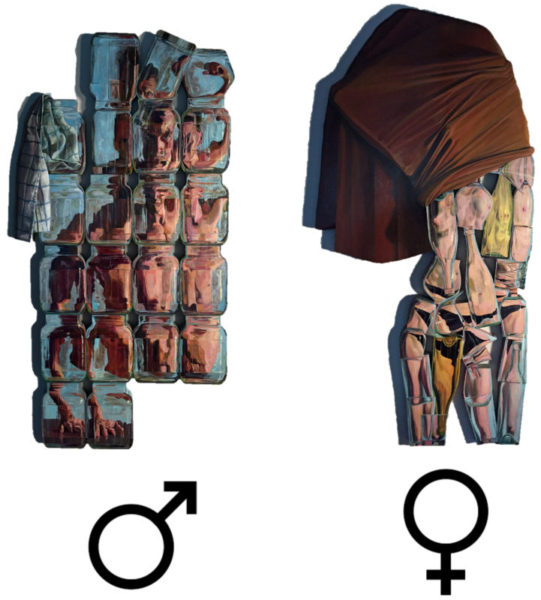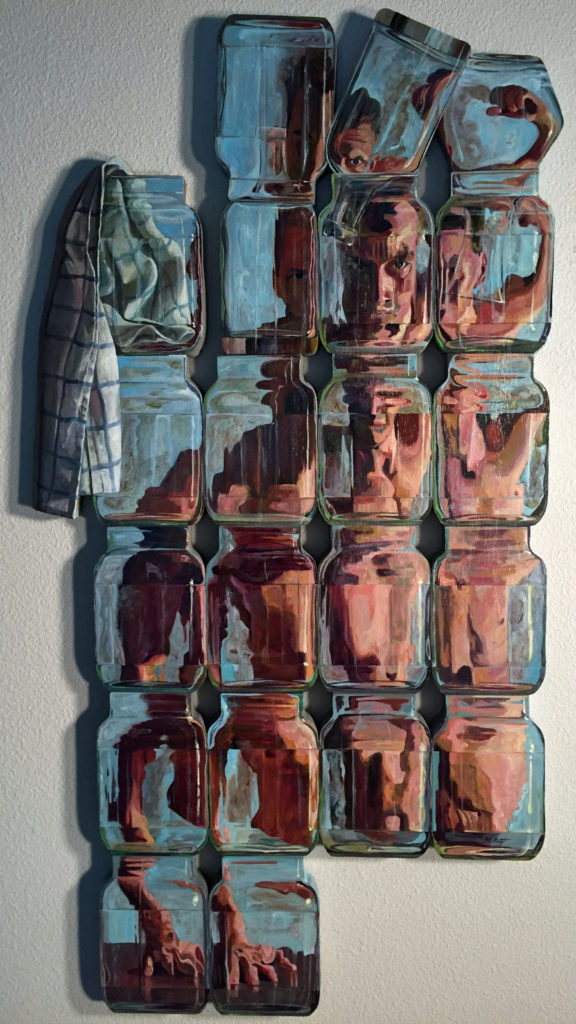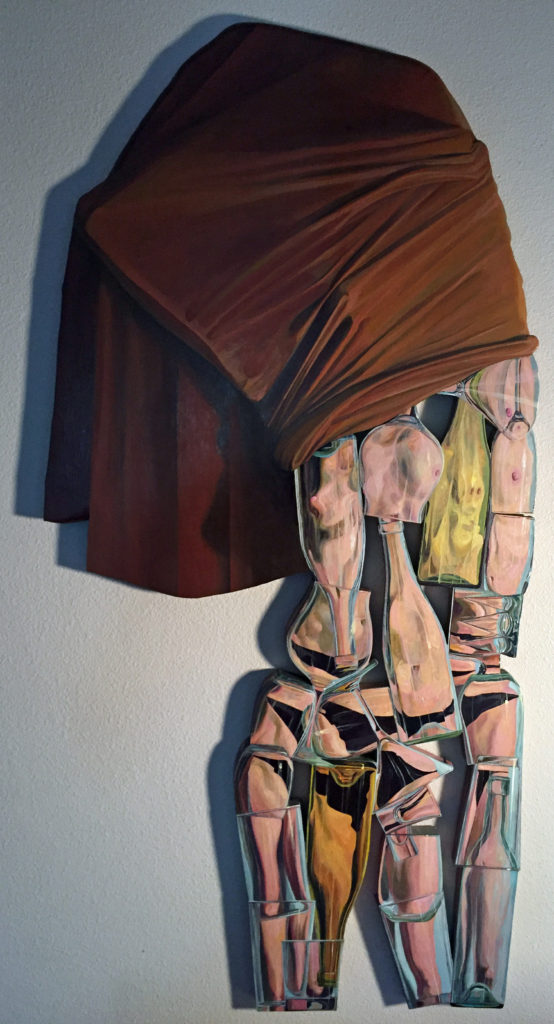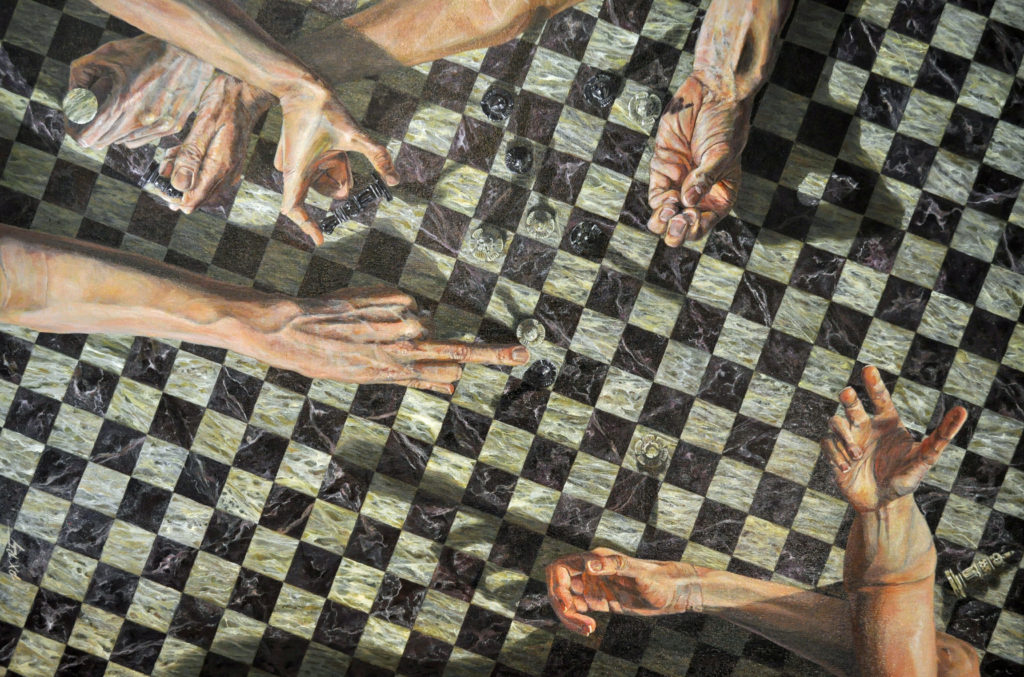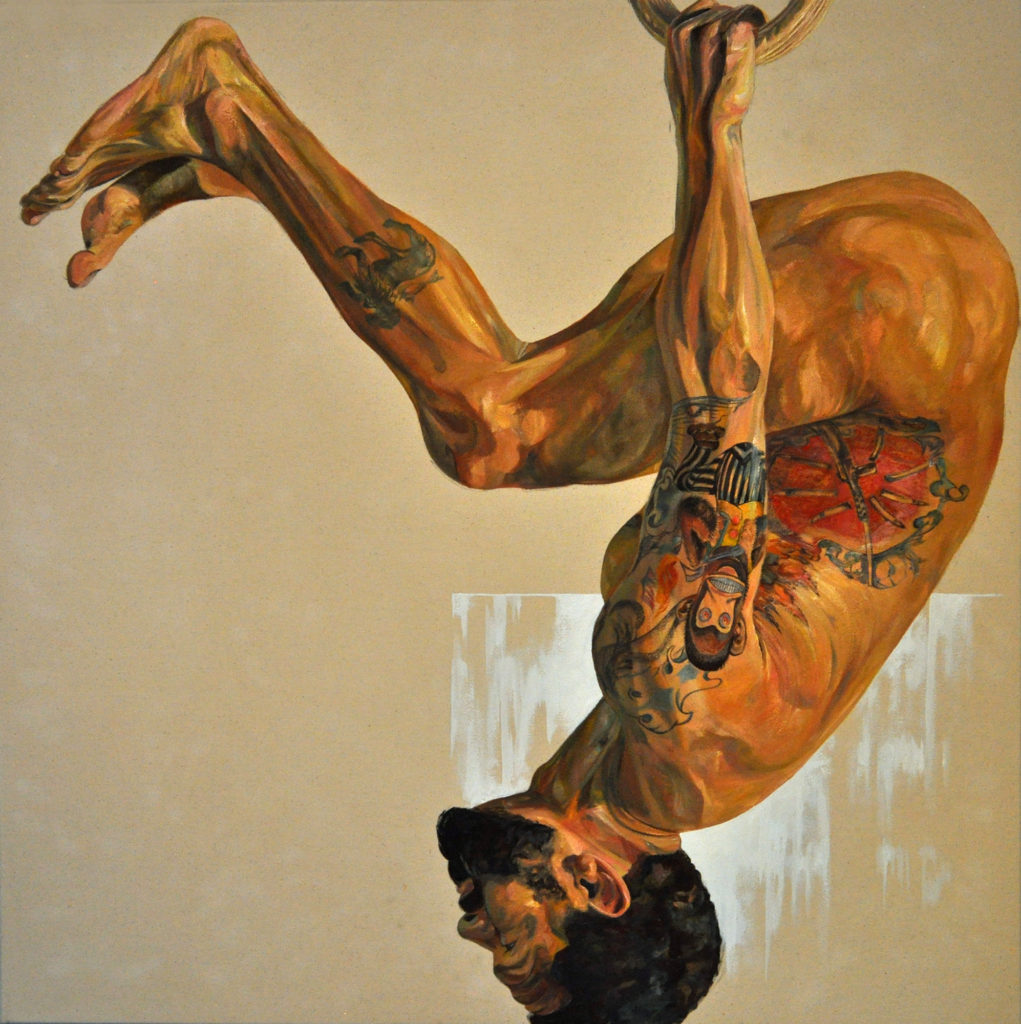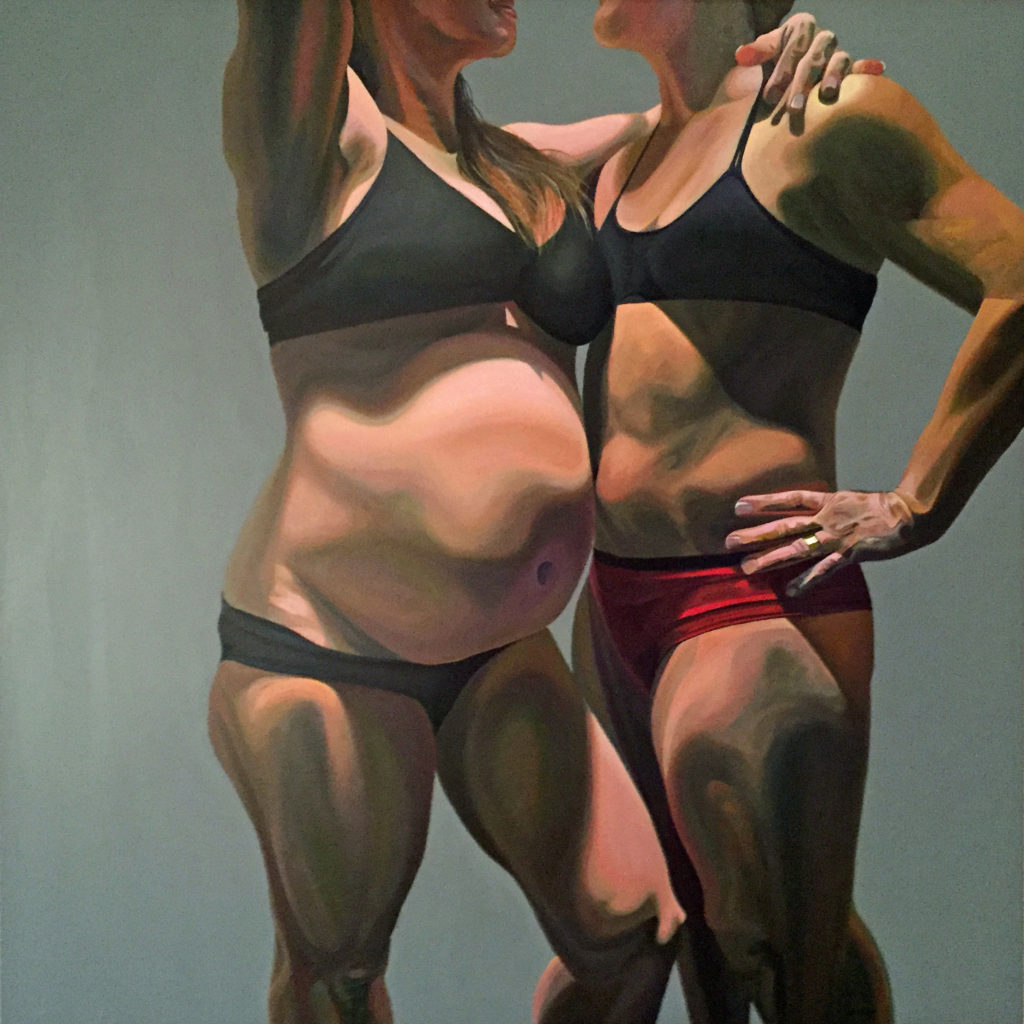
A Sci-Art group exhibition curated by Sara McCormick, featuring NW artists:
Opening Reception
Saturday, July 29 from 6 PM – 9 PM
The search for understanding is not finite. It is ever changing.
As science has become more accessible and present in our lives, artists have found a rich universe of ideas and imagery to explore. The development of new and greater technology has provided both scientists and artists with the tools to delve deeper into the nature of our own universe, sometimes even outside the realm of human vision. We are bombarded with news of scientific discoveries, it seems, almost daily. This flood of information can be both exciting and daunting. As a layperson, and from a broader cultural perspective, how do we process all this new information?
These Portland-based painters and sculptures draw their inspiration from science, including the study of anatomy, neuroscience, quantum physics, astronomy and biomimicry of nature. Through their own research and artistic insight, each lends a unique perspective to their chosen subject. Transforming theoretical concepts and scientific data into works that are both intriguing and informative.
Not only does science provide a wealth of inspiration for artists, the two practices have more in common than most people realize; both are about process, discovery, and a quest for understanding. By bridging the disciplines of art and science, we hope to create an exhibit that is beautiful as well as enlightening. We hope to show our viewers the power of wonder and the surprising connections between visual art and science.
The gallery show will be accompanied by live music starting at 8 PM, while EEG brainwaves are recorded LIVE from listeners and displayed on screen!
How does brain activity change in response to music? What patterns can you see? Learn more at: EPSPs Entropy
ARTISTS
Kindra Crick
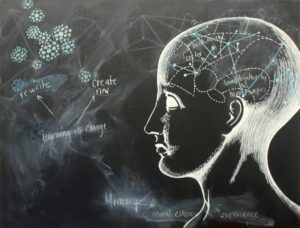
My work explores the intersection between the ‘two cultures’ of science and art which share a common wonder for the creative possibilities of the material and natural worlds. Trained both as a molecular biologist and as a painter, I’m fascinated by the human brain–our complex machine–which can fathom the beginning of time and the nature of its own thought. Even so, after centuries of study, neuroscientists are only now starting to chart the mysterious biological map of our cognition.
My goal is to visually express the mystery and process of scientific inquiry in my layered mixed-media objects through the incorporation of diagrams, data, maps, molecules and microscopic images which are then incised, written upon, erased or scraped back to previous layers. An artistic rendering of scientific information requires an acceptance of the inherent and often unpredictable nature of discovery: my art investigates how and where these worlds might intertwine and mingle.
Across my work, spherical constellations of connections cluster and collect like seeds or viruses. These forms spread across the surface, traveling beyond the confines of the figures that generate them. Although our memories are vulnerable, humans have transcended that fragility by binding ideas together and allowing them to live outside the confines of our mind by passing them on with language and art. Some memories and ideas are worth keeping. Do not erase.
In some pieces there is a figure of a phrenology head, a debunked theory and practice that mapped character and mental abilities to the bumps on a person’s head. This image is a reminder that science searches at the limits of its ability to observe. Neuroscience is a burgeoning field of study that no longer treats the brain like a black box. Still, we currently observe neural activity in the human mind indirectly and only look at functionality more directly in other animals. We learn more each day about activity and structures at a cellular level, but we still have a long way to go, building on the ideas that others have brought together, written down, and passed on.
My interests lie in the biological bases of what seem visceral and intangible — ideas, empathy, creativity, and memory. I follow cutting edge research with all its missteps and conjecture. My ideas for work stem from lectures I’ve attended or articles I’ve read which I allow to percolate until inspiration finally rises to the surface of my creative process. Artists and scientists share a curiosity for the world and a willingness to tread into uncharted territory all while observing what others miss. This is why I’m not only interested in replicating images from science, but my desire is to amplify the unknown and give shape to human curiosity and thought.
The Mad Pursuit
One of the greatest mysteries of the mind is our memory, the ability to time-travel and use recollections, whether conscious or not, to shape our future choices. At our core, when we think about who we are, we rely on a narrative we remember, the treasured memories we hold dear: grandparents, a summer adventure or the electricity of first romance. Depending on your age, you might have held onto these memories for just a few years or for several decades. Instinctively we know our memories are only a shadowy artifact of our original lived experience, and one which has been distorted over time. In some ways memories have a life of their own: their own trajectory, their own constant shape-shifting, their ebbing and flowing in time. Many have no narrative, but rather are more an influence over fears and feelings.
As Eric Kandel, a remarkable memory pioneer in brain science, has stated, “Has it ever struck you… that life is all memory, except for the one present moment that goes by you so quickly you hardly catch it going? It’s really all memory…except for each passing moment.”
With books, photographs, and works of art, we create touchstones in our lives by committing a thought to paper or etching an image in time, creating a physical substrate that will lock in connections, fleeting thoughts or a visual representation of a person, place or encounter. But how our brain recalls and maintains the constellations of the interconnected details of our life decades after those connections were made is still a mystery. How do specific brain structures, such as the hippocampus and other parts of the medial temporal lobe, somehow bind together, consolidate, and enable recall of our declarative memories? What molecular mechanisms lock in our long-term memories, these neural echoes of our experience? Scientists believe that increases in the strength of synaptic connections are critical for memory formation. How flexible are they and how do they change over time and as we age? We also know that sleep plays a role in the consolidation of memory, which is essential for learning new information, but again the exact mechanisms are not entirely understood. Sleep can extract the emotional gist, the rules or the essence of declarative memory as well as enable us to better recall procedural memories such as the fingering of a song on the piano or the most effective way to launch a shot put.
I’ve always been curious about how our minds learn and remember. During the fall of 2015, I had a chance to work with Dr. John Harkness as part of a collaboration through NW Noggin, a Pacific Northwest neuroscience outreach group. Dr. Harkness is a postdoc fellow in the lab of Dr. Barbara Sorg at WSU, where he investigates the role of perineuronal nets in memory and cocaine-relapse behavior. These extracellular structures are thought to be important in maintaining neuroplasticity, the ability to form and reorganize synaptic connections, in response to learning and experience. Our collaboration inspired an immersive art installation, a forest of towering neurons, magnifying and reimagining the hidden molecular structures of the mind. This illuminated Cerebral Wilderness aimed to evoke the wonder of discovery and offer an imagined vision of the spectacular biological machinery which comprises the very core of our memories and our essential sense of self.
Developed in tandem to this installation, I started a series of mixed media paintings building up layers and imagery on a series of chalkboards. My goal was to call attention to the quest to unlock the mysteries of the human mind and the fragility of our memory. I started by building and erasing layers of written ideas and recollections, leaving a patina of dust or a gist of what was important. With a chalkboard, it’s so easy to edit the surface, leaving some parts while erasing others. The longing for permanence in this delicate matrix is explicitly stated in the chalked-on words ‘Do not erase.’ Memory, the scientific method, and the changeable surface of a chalkboard allow for iteration and change. There is value in rewriting and even in forgetting; this process enables us to learn and adapt to new experiences in our ever-changing world.
Lawrence Morrell
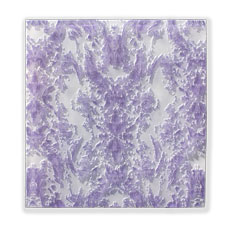
The elegance of the nearly invisible world of molecular biology defines Morrell’s artwork. His innovative sculptures describe reimagined life forms in luminous and intricately textured glass. He is preoccupied by the new science of synthetic biology. Similar to the way scientists may reengineer an organism’s function by rearranging its genetic structure, Morrell uses computer software to reorganize images from the natural world to use in his work. His fused and carved glass sculptures are informed by these images, describing a refined surface of dense, organic textures in this very solid yet translucent material.
Morrell was born in Oregon and spent 15 years in New York City creating sculptures for Cartier, Saks 5th Ave. and a two story glass facade for the Milennium at Times Square Hotel. Collaborating with other artists, he created the New York Vietnam Veterans War Memorial in carved, illuminated glass. He was interviewed on National Public Television on The McNeil Lehrer News Hour about the experience. In 1995 he moved to the vibrant West Coast art glass community in Portland, Oregon, creating sculptures for VISA International and an actively illuminated, 30 foot long horizontal sculpture for The Portland Center for the Performing Arts. Inspired by the lush, botanical diversity of Oregon, he created a glowing, spiral glass staircase. The transparent steps were hollowed out with a pine tree branch and needle motif and filled with thousands of illuminated fiber-optic strands that softly undulate with color.
Morrell is currently exhibiting at the United States Embassy in Doha, Qatar as a part of the Art in
Embassies program and has taught art in Switzerland and New Zealand. His sculptures and art
installations are collected nationally and internationally.
The Mad Pursuit
I am interested in the structures of minute, living organisms that surround us but are invisible to the naked eye. These elegant textures have been refined by evolution over millions of years into the most efficient shapes for each organism’s purpose. Now, scientists are starting to redesign these living organisms using the new science of Synthetic Biology. This scientific frontier, which has the power to solve many of humanity’s current and future problems, excites my imagination and informs the current direction of my work.
To create my sculptures, I combine images from the natural world, the bio-sciences and my own photography with other forms into my own, newly imagined bio-organisms. I use computer programs to synthesize different images and textures using a modified photolithographic process. I then reductively carve these two dimensional images into colored layers of melted glass, creating translucent and intricately textured bas relief sculptures.
Some of my artwork is characterized by organic webs of spherical cell textures that are deeply incised into luminous glass, others by intricately laced insect wing structures that seamlessly morph into the faceted surface of an insect’s eye, mirror imaged and abstracted.
In the future I want to explore this subject matter further, particularly as it relates to the way living organisms use light at the cellular level, and the new research field termed Optogenetics, in which scientists use light to change cells in living organisms. The pace of scientific developments is accelerating and provides me with new and challenging opportunities for visual exploration of the natural world at its most elemental level.
Sienna Morris
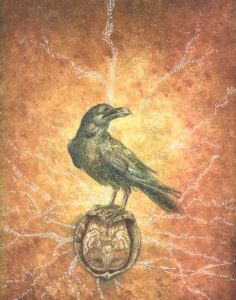
“Numbers are beautiful. If they aren’t beautiful, nothing is.” Paul Erdõs
Every mark in my work is a number or an equation drawn by hand.
I am not a mathematician, I am not a scientist, and I have no real artistic training. If you gave me a multiple choice question about education, I would tick off the little box next to “some college”, and even then I would just barely qualify. I’ve come to my love of science organically, and I’ve never known any other way to be than an artist. I’m self taught in most everything I do, so I’ve really made a career of being curious and persistent.
My pieces take me an average of 200 hours to draw and upwards of a year to research. My media is pen, pencil or color pencil on paper or etchings on scratchboard, metal or glass. I use the smallest nibs I can find and often work under a magnifying glass.
Without a math or science background, studying things like the body and brain can be daunting. I have found that illustrating what I’ve learned with data that define the subjects function, connects me to it in a meaningful way and provides me with a lasting memory of the material. As an artist and science enthusiast, it is impossible to learn and not be inspired. This work is my way of sharing that awe and love with you as it continues to motivate me to study and learn about subjects that may seem out of reach, given my background.
The Mad Pursuit
Anatomy and Physiology
The pieces you see here are from my ongoing series on the body and brain. My research into this series included hands-on research in dissection and microscopy in my humble little ad hoc home lab as well as online open course ware, text books and the Internet. My long term interest is in the brain, consciousness and mental health. I decided to start with physiology and move my way “up” as it were. These pieces are drawn entirely with numbers and equations relating to how the body functions, from math used to calculate the health of a human heart to equations explaining how a neuron fires and how that signal is sent along axons throughout the central nervous system. Full descriptions accompany each piece and are included with any purchase.
Julian Voss-Andreae
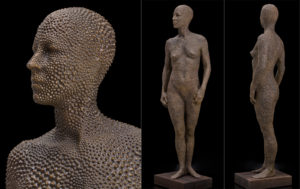
Contemporary technology is ushering in a new era for sculpture, comparable perhaps only to the invention of metal casting during antiquity. In my work I draw cutting-edge approaches from very diverse fields to re-imagine the ancient art of figurative sculpture. My goal is to convey elements of our spiritual essence and open our eyes to the miraculous nature of the underlying nature of reality.
I started out as painter in my youth and later switched to physics. I studied at the universities of Berlin and Edinburgh, and did my graduate research participating in a seminal experiment probing the foundations of quantum physics in one of the world’s leading research groups at the University of Vienna. My science training enables me to take advantage of the latest technologies to achieve my artistic visions. But most importantly, my first-hand experience of the enigmatic nature of reality has provided me with key cultural insights, informing my path ever since. Contrary to our strongly held prejudices about the workings of the universe, there simply is no ‘reality’ out there that is independent of us. Similarly, the divide we perceive between us and the rest of our world turns out to be an illusion: Ultimately, we cannot separate ourselves from each other and the rest of the universe, both in a physical sense as well as when it comes to our actions. These kinds of ideas were well-known for millennia in certain Eastern spiritual traditions but in the West they appeared only relatively recently, at about the same time as non-representational art emerged in the early twentieth century. Quantum physics came as a complete surprise even to its discoverers and it stands in striking contrast to the old (and still absolutely predominant) ‘Newtonian’ paradigm, the mindset of separating subject and object, of detaching ourselves from nature, and of dividing the world into small parts assuming this will lead to an understanding of the whole. Art is holistic in its very essence, both when we create it, as well as when we consume it. And art provides the seeds for our future. Before our future happens, we have dreamt it up. And the central place where we, as a collective mind, dream up our future, is in art. It is therefore critical to harness the transformative powers inherent in art to get to the future we want. I believe a cultural change comparable in depth to the Renaissance is imminent. The urgent need for a paradigm shift is most obvious in our reckless attitude toward our environment; we are jeopardizing our future by rapidly making our planet uninhabitable. Art is a powerful driver of the cultural and spiritual change desperately needed. The lessons of quantum physics offer us a glimpse of a different way of dealing with each other and dealing with our world and I feel it is critical that those embryonic ideas get out into the cultural mainstream. My work is a reminder of our fundamental connectedness, giving tangible expression to the vital paradigm shift from Newtonian separation to a renewed connection with Nature.
The Mad Pursuit
Science has inspired my work since my days as an art student when I began to create sculptures based on the form and function of proteins, the molecular building blocks of life. Throughout my art studies I also retained a strong interest in the field that had most fascinated me as a scientist: quantum physics and its philosophical implications. Quantum physics is the scientific foundation of practically everything we encounter in the world, ranging from virtually every aspect of current high technology to the miracle of life itself. Despite its overwhelming importance and its fundamental status in science, quantum theory remains philosophically extraordinarily problematic.
With our intuitions schooled within the paradigm of classical physics, we tend to assume that reality has definite properties, regardless of whether or not there is anyone around to observe them. This view, called “objective realism,” turns out to be incompatible with quantum theory. For example, there is no accurate space-time representation of, say, an electron: It is neither a particle nor a wave nor any other “thing.” So, when attempting to visualize concepts from quantum physics, there is a danger in presenting artificially concrete representations without making sure they are correctly understood as only a facet of something more complex or as something altogether different. There is always a danger of taking any image or model too literally. Using images in science or philosophy to illustrate states of affairs is generally a two-edged sword, because it is essential for the audience to know the limits of a picture and use it with discrimination and intelligence. With that caution, I believe that art in general, especially once we dispense with the requirement that it visually represent reality accurately, is uniquely capable of instilling an intuition for the deeper aspects of reality that are hidden to the naked eye. The ability of art to transcend the confines of logic and literal representation, and to offer glimpses of something beyond, can help us open up to a deeper understanding of the world. This way, art can help wean us from the powerful grip that the worldview of classical physics has had on our every perception of reality over the past centuries.
In quantum theory, matter is mathematically described as a wave, and therefore each portion of moving matter is associated with a specific wavelength: the distance between two consecutive waves. My former group leader Anton Zeilinger once remarked jokingly that the fact that the wavelength associated with a typical walking person happens to be approximately the Planck length cannot possibly be a coincidence. This comment made me think about what such a wave-function might look like, and a few years later I created a series of sculptures inspired by this idea. Modeled in the shape of a stylized human walker, Quantum Man consists of numerous vertically oriented parallel steel slabs with constant spacing to represent the wave fronts. The slabs are connected with short pieces of steel. These irregularly positioned connectors between the regularly spaced slices evoke associations with stochastic events and, more concretely, with the formulation of quantum mechanics in terms of path integrals. When approached from the front or back, the sculpture seems to consist of solid steel, but when seen from the side it visually disappears almost completely. This fascinating effect offers a range of possible interpretations. In the context of quantum physics–inspired art it is natural to see Quantum Man as a metaphor for the wave-particle duality, the phenomenon that all matter exhibits wave-like or particle-like properties depending on the experimental question we ask: Quantum Man’s particle-like concreteness when seen from the front shifts to wave-like near-invisibility when the sculpture is viewed from the side.
The simultaneous advent of quantum physics in the sciences and the rise of modernism in the arts in the early 20th century marked a profound shift in the cultural evolution of humankind. The uneasiness many of us experience when dealing with either illustrates how little we have grappled yet with the consequences of this paradigm shift. The sculptural work presented in this article aims to explore the character of this shift by transforming ideas that emerged in the isolated intellectual realm of quantum physics into art that evokes a sensual experience. My hope is that my work will help to lift those ideas into the sphere of our collective consciousness and aid us in intuiting the unfathomable deeper nature of reality.
Elise Wagner
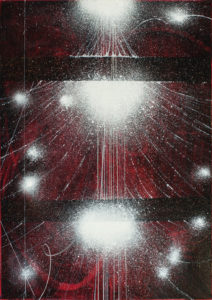
The physical wonders of the world spark my imagination, and as an artist, I feel compelled to respond through the creation of art. My work, like science, manifests through discovery, learning and remaining open to new ways of understanding and interpreting the world around us.
As an artist, I feel a strong responsibility to transcend and distill human concerns through my art making. The narrative for my work combines contemporary contrasts found in nature and science as its template and is created by way of continual unearthing in both concept and materials.
My studio practice is fluid and multidisciplinary and explores the contradictions between chaos, the indifference of nature and the human impulse to comprehend through exploration. Using four mediums, encaustic and oil painting, drawing and printmaking, the work weaves a continuous thread. I work as if I am navigating an uncharted path, facilitating a conversation between all disciplines.
The Mad Pursuit
The revelations of science are available to us all, and as an artist, I am interested in melding my understanding and curiosity about these discoveries with my chosen materials. All branches of science – astronomy, physics, meteorology, geology, biology and environmental – have provided me with an evolving visual vocabulary of my own.
Science isn’t just for scientists; it is the discovery of the natural world, manifest and understood through observation and experimentation. Creating art works much in the same way. For artists, concepts are borne through observation, and often executed by means of experimentation and discovery in materials. Artists throughout history have played an essential role in interpreting the world around us. Art has the power to express a deep and profound understanding of human activity in society, nature, technology, culture, science, climate and geo-politics.
Two underlying ideas that have always dwelled in my creative consciousness and have motivated me to continue creating art, are the human impulse for order amidst the indifference of nature, and how we as humans have impacted nature and the environment.
Some of the works I selected for this exhibit use the word “transits” or “collision” or “collider” in their titles. These are references to particle movement, and to the images that are revealed through sophisticated technology and the gathering of data. Several bodies of my work have addressed neutrino particles; event horizons, solar flares, storms, the Pluto Flyby, gravitational waves and the receding ice shelves. The contemporary relevance of these events has coincided with my artistic development.
Artists have the power to transcend. The narrative that I take with subjects specific to my work combines existing contrasts found in nature and science in an attempt to distill the unknown, unseen and incomprehensible into visual art.
Exhibition runs through August 23rd.


